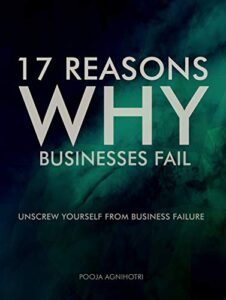The difference between business failure and success: Have you ever visited any street after a gap of a few years?
What do you notice generally?
Do you notice some new businesses in that area? Or do you find yourself amazed at noticing how some of the best shops, stores, or showrooms in that street no longer exist?
Have you ever wondered why it happens?
Why are some businesses able to last for many decades while some others just disappear in a few years?
Why am I eating cookies from a 1953 bakery whereas a juice shop close to my home has gone out of the business in just 2 years?
There is something that differentiates business failure and success and that is what we are going to figure out in this article.
Business Success vs Business Failure
The two important factors that move a business away from failure, towards its success, are:
- Great business idea
- Strategic planning for that idea
Let’s understand how those two impact the future of a business.
Business Idea: The First Difference Between Business Success & Failure
The difference between business failure and success is a unique business idea.
Your business idea needs to be realistic, unique, and problem-solving. If you come up with something that is boring, it won’t succeed as the market is already flooded with so many boring products.
There are so many cosmetics stores, so many bakeries, so many clothing stores and they all are the same. Being the same is being bored, at least in the world of business.
You don’t want to be a customer’s accidental choice, you want to be your customer’s only choice.
The success of your business depends on how well you understand your audience and their needs and how irreplaceable you are in your customers’ hearts.”
How to Come up With a Great Business Idea?
Step 1) Find Something Unique
If your business idea is to open another cafe, you can be easily replaced tomorrow by another one. That’s why you have to figure out what you can do differently to stand out, to become irreplaceable.
Can you serve the same coffee fastest than any other in the neighborhood?
Or can you provide the best quality of the coffee?
Can you provide superior customer care service?
Can you juggle balls while serving coffee?
Not exactly that but it can be anything that can make you remarkable and worth talking about. When you’re able to figure that out, you have solved the first half of this business problem.
Step 2) Find Something That Solves Problems
Another thing to remember is that your product should always be problem-solving. You need to understand your customers’ needs like you understand your own needs.
Try to work on an idea that aims at solving some kind of customer problem. When you do that, sales will follow automatically.
But if you focus on creating a product that earns you a lot of money, customers may or may not follow.
Step 3) Never Stop Improving Your Idea
Another key point about business ideas you have to remember is that what’s making you unique today might not make you unique tomorrow?
You can provide the best mobile phones today but tomorrow it can be somebody else providing a better, braver, bolder version of your products.
Remember the times of Nokia and Blackberry phones. Businesses are replaced by other businesses all the time.
That’s why just coming up with a unique idea is never enough.
The next crucial step in this process will be to continuously innovate. Learn more about your customers and figure out why they like you.
If they like you for your customer service, and tomorrow your competitor starts providing a similar level of customer service, are they going to leave you?
If yes, what can you do to make them stay? Can you become from the best service provider to the fastest service provider or fastest to easiest or something else? Become best at something, if you want to last.
Strategic Planning: The Second Difference Between Business Success & Failure
The difference between business failure and success is strategic planning. When you have an idea ready, then the next significant step in its planning and implementation.
The right planning of your business idea will bring you closer to success and that’s why it becomes so necessary to learn more about strategic planning.
What is Strategic Planning?
Strategic planning is the process of figuring out the strategic fit between what you want to achieve from your business or what your business capabilities are and the changing marketing opportunities in your industry.
Strategic planning is about taking advantage of opportunities in a constantly changing business environment.
How to Strategically Implement Your Business Idea?
Step 1) Define Mission & Vision
The first step of any strategic planning is to develop your mission & vision statement. A mission statement defines why your business exists.
In other words, you exist because you want to accomplish something and you want to be a part of a bigger picture.
What is that big picture for you?
Don’t make the mistake of defining your business mission in terms of your products. Define it in terms of customers and their needs.
You are not in the business because you want to sell more shirts, coffee, software, or something else. You exist for something more.
Find that purpose and then use that purpose as a guide for all your future plans.
There is a reason why Apple is not a laptop seller, Amazon is not a grocery seller and Starbucks is not a coffee seller.
They have focussed their mission statement on the bigger problems of their customers rather than the features of their products.
You have to understand that your product can be replaced tomorrow, but the need to satisfy that problem will still remain in the customers.
Customers can move from typewriters to computers, but the need for fast communication will continue to exist.
Step 2) Define Objectives And Goals For Your Mission
The next step in the process of strategic planning will be defining your business objectives and goals.
Your business objectives can vary according to your departments but your mission will unify them by providing the same destination to reach.
While the goal of your HR department can be to hire the best employees for you, or the goal of your finance department can be to keep the cost low, in the end, they all will be working to fulfill your mission.
Moreover, follow the SMART technique to define your goals which will make it easier for you to see what is working and what is not.
SMART stands for specific, measurable, attainable, relevant and time-bound.
Step 3) Decide the Portfolio of Your Products
After this, you are required to define the portfolio of your products. What are all products or services you want to provide?
Do you want to sell books just like Amazon did in the starting or do you want to sell a lot more as they do now?
You have to remember that not all the products/services in your business portfolio are going to do well with time.
If you find any product/service is not profitable anymore or is not fitting your mission statement anymore, it’s time for you to downsize.
For example, let’s say you were selling an oil-based product but your customer is now interested in an electric version of the same as it’s better for the environment.
Then it’s the right time for you to start investing more in innovation and start downsizing your current product.
Step 4) Developing Marketing Plan for Every Product
Finally, you are now ready for developing marketing plans for a successful business plan.
Pay attention that I didn’t say ‘marketing plan,’ I said ‘marketing plans.’ One marketing plan is not enough for your business portfolio of more than one product.
Every product you own will need a different marketing strategy.
If you are selling toothpaste and toothbrushes, you need two marketing plans. If you are selling those in two different counties then you need four marketing plans.
In addition, your marketing plan should focus on building customer relationships.
Marketing is like your partner in attracting, engaging, and growing your customers but it’s not the solution for a product that is not needed in the market or is not solving any customer problem.
Generally speaking, every department in your business should add some value to your customers’ lives, only then you can expect a successful business plan.
A company’s value chain is only as strong as its weakest value-addition department.
If you want to take your marketing plan seriously, start realizing that everyone in your business is responsible for marketing. Marketing has never been restricted to just the marketing department.
Any touchpoint is an opportunity to delight your customers and many times those touchpoints happen with your other team members and not just with marketers. Determine your business success or failure.
How to Move Your Business Towards Success From Failure?
The art of growing a successful business is easy and starts with a fundamental question. Have you ever encountered a situation where you tell somebody you are a business owner and the next question that they shoot at you is what are you selling?
I am very sure you have experienced this situation more than once in your life. I have. So, let’s get to the root of this question.
- Are you selling a product?
- Or, Are you selling a service?
- Selling a designer dress?
- Are you selling website designing services?
- Or something else?
Many times when business owners were asked this question, they try to give a fancy answer like I am selling the dresses made by the world’s best designer, or I’m selling the fastest website designing services.
Even in the above cases, you have not yet hit the target. The moment you will be able to understand the right answer to this question will be the moment that will change the way you run your business.
This is going to define the path of your marketing strategy and in doing so it will also explain the art of growing a successful business.
Let’s first understand what can we sell in the market to make your business a successful one and let it differentiate from the one that fails.
What All Can Be Marketed?
Things that you can market generally fall into seven categories. These are –
-
-
Product Marketing
-
Product marketing is the most common form of marketing.
Anything that you can see and touch falls in the category of products and marketing such as product marketing.
For example- shirts, drinks, burgers, medicines, electronics, etc…
-
-
Services Marketing
-
Many times the thing that you are selling is not visible because it’s a service.
Marketing involving services is service marketing.
For example- banking services, healthcare services, education services, airline services, travel services, and many more.
-
-
Person Marketing
-
Not just products and services, many times even people can be promoted.
The most common example of it is celebrity marketing where a celebrity is famous.
Recently social media has accelerated the growth of personalized marketing.
They are bloggers, they are chefs, they are musicians and all of them promote themselves.
So, this is personalized marketing.
-
-
Places Marketing
-
Many times even places can be marketed.
Places like tourist spots, cities, and countries. You must have seen ‘Pure Michigan’ tagline being promoted by the Michigan state.
If you have been to India, you must have heard ‘Incredible India.’
These are a few examples of places marketing.
-
-
Organization Marketing
-
Even organizations can be promoted like PETA.
So, organization marketing is famous to create, change, and maintain the image of an organization.
-
-
Information Marketing
-
Information forms a very important product in the digital age.
With such an increased demand for data, information is being sold and bought a lot.
Hence, Marketing information to the right users is information marketing.
-
-
Idea Marketing
-
When the thing that you are selling is an idea is idea marketing. So, It can be an idea of a future possibility. It can be a hope of a better future.
So, What Are You Selling? What Kind of Business Do You Have?
Before you answer this question, always remember that you are selling a solution to a customer’s problems. Only when you provide solutions to your customer’s problem will you be able to differentiate your business from a failed business and gain success.
As a result, the first step for finding the right answer will be to identify the right problem – the root problem.
Hence, don’t be distracted by various outer layers of that problem that you are seeing, go deeper.
Case 1: Drilling Machine
Let’s imagine you own a business of drilling machines. Now try to answer the question.
Are you selling a drilling machine? NO
Are you selling a hole? NO
Then, what is it?
You are neither selling a drilling machine nor selling holes.
You are in the business of selling the freedom and independence that comes when you are able to do a drilling job yourself.
Not only this, you are selling that amazing feeling a person gets when they look at a painting hanging on that wall.
You are selling the improved status when guests come over and appreciate the way your home looks.
Case 2: Barack Obama
It was not a very long time ago when Obama ran for the presidency. Do you remember what was selling?
Was he selling himself? NO
Was he selling his expertise as a politician? NO
Also, the real answer is that he was selling hope.
Remember his tagline “Yes we can.’ He was selling hope for a better and improved future.
Word of Caution: Business Success vs Business Failure
Before you figure out what you are selling, you should never forget the importance of setting the right expectations. This is what will differentiate business success or failure.
You can promise anything to your customer but if you don’t deliver on your promises, you will lose trust and eventually your business.
Certainly, that’s why make sure that your answer sets up the right expectations. Neither too high nor too low.
Too high expectations make your customers feel disappointed and too low expectations lead to the loss of many highly qualified customers.
Key Takeaway: What Separates Business Success From Failure
The difference between business failure and success is the desire to serve your customers, it will drive your business to success and growth.
A successful business plan starts with a great business idea and proper strategic planning. You have to do both things perfectly if you want to stay in the market.
If you think you can use some help in your strategic planning, get in touch with us. We have over 15 years of experience in marketing and advertising.
Smart Business Owners Learn from the Mistakes of Others
The secret to success in business isn’t doing what other successful people have done; it’s by avoiding the mistakes made by businesses that have failed. Instead of repeating their mistakes, now we can learn from them and best ensure business growth and commercial success.
17 Reasons Why Businesses Fail brings the cautionary tales of mistakes made by many businesses that ultimately led to their failure and which other businesses should avoid at all costs if they plan to survive and grow. Get your copy.











